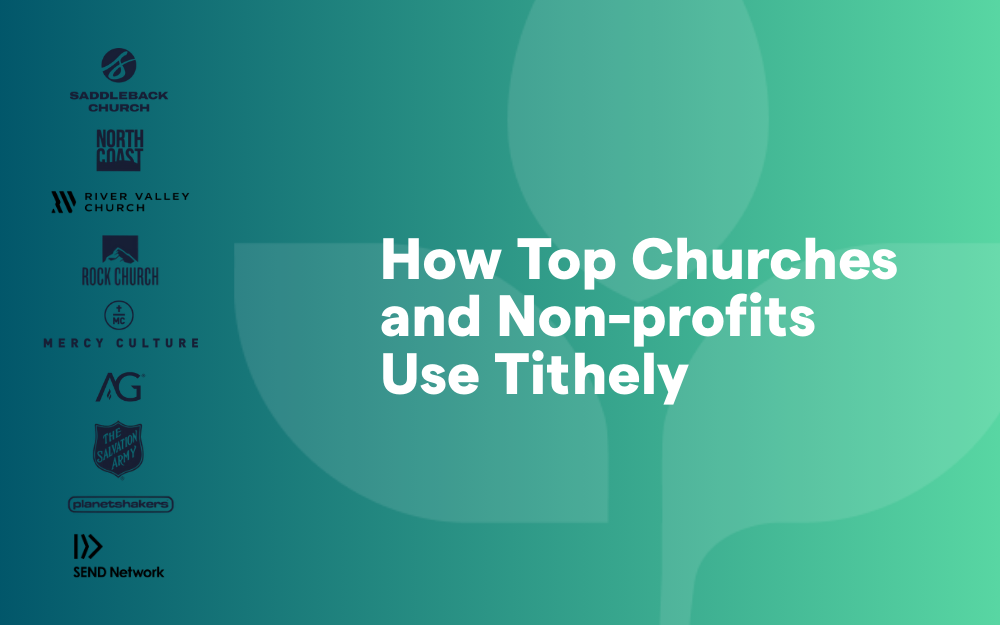Church Giving Fatigue: What it Is and How to Recover
Do your church members not feel like giving? Don’t worry. It’s common. Here we share how to diagnose and prevent giving fatigue in your church.

Giving fatigue is a common phenomenon in churches.
The new building is halfway done.
The childrens’ programs are almost fully funded.
A new round of missions trips are about to launched.
And … people are tapped out.
They don’t feel like giving.
They have their own financial needs.
They have their own stress related to the expenses of life or concerns about debt.
So, as a church leader, how do you strike the proper balance between making bold asks for the kingdom of God and making your people feel like they have to choose between financial stability and participation in God’s work?
Here, we’re going to unpack all of the relevant information to answer that exact question.
1. What church giving fatigue is.
Church giving fatigue can occur when your congregants feel that you have asked too much from them financially for too long.
This experience can sometimes accurately reflect (1) a poor church fundraising strategy on the church’s part, or (2) a personal experience of losing connection between the act of giving and the purpose of giving.
In the first case, the church has often made fundraising goals that are not realistic for the church—whether unrealistic as a matter of total amount raised or the pace at which those funds are raised. If your church is maxed out financially funding the mission of your church, then you have put your church in the poor position of operating with no financial margin, with no growth to pad that margin, and no extra cash to raise from members.
Sometimes, every active member could be giving as much as they are able, and due to poor operational and fundraising strategies, the church is still not able to do what it wants to do. In this case, giving fatigue sets in and begins to drop, further forcing church leadership to make cuts that they should have considered far earlier.
In the second case, the church is responsible to help members to catch a vision for giving by showing them how their money is making an impact. People want to see growth. People want to see programs, projects, and outreach events that connect with them on an existential level. In this case, giving fatigue is much more about the culture of the church than it is about the capital available within the church.
How to prevent church giving fatigue
Lead with vision
We do not give one dollar to God that doesn’t produce fruit.
“God is not unjust; he will not forget your work and the love you have shown him as you have helped his people and continue to help them” (Heb. 6:10).
People give when they are inspired. By leading a church offering with vision, you help your members to catch a glimpse of the world they could help to create and turn the idea of a better future into an actionable reality that requires funding.
Telling compelling stories during church offerings is also known to inspire generosity.
Place love at the forefront, not guilt
“If the willingness is there, the gift is acceptable according to what one has, not according to what he does not have” (2 Cor. 8:12).
It’s common to lean into guilt for giving appeals, because financial inequality feels like something that has a morally negative quality. But the truth is that, while guilt may increase cash flow for a month, it is not a sustainable fundraising strategy in the long-term.
Donors want to feel they belong in and are loved by the organization to which they give. By leading with vision, church leaders can replace guilt with love as the basis for a fundraising appeal.
Complete projects
There is an easy way to create fatigue in athletes: Tell them there is no end.
When people sense that the project to which they have been giving to is not moving at a fast enough pace, they feel as if their sacrifice (which was often difficult) is not being managed well. Or, they sense that they are the only ones making a sacrifice.
The most difficult, but the most powerful, way of staving off giving fatigue is to actually complete the projects to which people give money. People can endure hard sprints more easily than they can endure low-grade marathons. Church capital campaigns can often get stuck in seasons of incompletion for decades.
Celebrate wins
“Everyone who was willing and whose heart moved him came and brought an offering to the LORD for the work. All who were willing, men and women alike, came and brought gold jewelry of all kinds: brooches, earrings, rings and ornaments. They all presented their gold as a wave offering to the LORD” (Ex. 35:21-22).
Finally, when your church does complete a project, you need to celebrate that win before you launch your next giving campaign or capital project. People want to feel as if they’ve achieved something through their sacrifice. The more sweet you can make the reward for sacrifice, the more your members will look forward to giving more money during the next campaign.
Do this by throwing parties, hosting meals, thanking donors by name, writing cards, hosting a launch party, or ribbon cutting ceremony. Ritual is a powerful way to bond people together after a season of endurance, and there is no better ritual to catalyze social cohesion than an event filled with fun, recognition, and worship of the God who supplied the needs for which you prayed.
During this event, ask God’s blessing upon the project, building, or endeavor in order to help your members receive a fresh sense of mission, purpose, and completion. This is a way of recognizing the value which was created by the value given up in the form of tithes and offerings.
Over to you
Use this understanding of giving fatigue to help your church members feel that their giving is meaningful, worshipful, and sustainable.
When your members feel their investment in God’s kingdom work through your church is making an impact, they will see the purpose of the pain of giving and become reacquainted with the blessing of giving.
When you can remove guilt as a primary motivator for giving and place love at the center, you will find that this will yield more giving for your church in the long-term as your membership grows and witnesses all that God can do through the power of a generous church member base.
Sign Up for Product Updates
Giving fatigue is a common phenomenon in churches.
The new building is halfway done.
The childrens’ programs are almost fully funded.
A new round of missions trips are about to launched.
And … people are tapped out.
They don’t feel like giving.
They have their own financial needs.
They have their own stress related to the expenses of life or concerns about debt.
So, as a church leader, how do you strike the proper balance between making bold asks for the kingdom of God and making your people feel like they have to choose between financial stability and participation in God’s work?
Here, we’re going to unpack all of the relevant information to answer that exact question.
1. What church giving fatigue is.
Church giving fatigue can occur when your congregants feel that you have asked too much from them financially for too long.
This experience can sometimes accurately reflect (1) a poor church fundraising strategy on the church’s part, or (2) a personal experience of losing connection between the act of giving and the purpose of giving.
In the first case, the church has often made fundraising goals that are not realistic for the church—whether unrealistic as a matter of total amount raised or the pace at which those funds are raised. If your church is maxed out financially funding the mission of your church, then you have put your church in the poor position of operating with no financial margin, with no growth to pad that margin, and no extra cash to raise from members.
Sometimes, every active member could be giving as much as they are able, and due to poor operational and fundraising strategies, the church is still not able to do what it wants to do. In this case, giving fatigue sets in and begins to drop, further forcing church leadership to make cuts that they should have considered far earlier.
In the second case, the church is responsible to help members to catch a vision for giving by showing them how their money is making an impact. People want to see growth. People want to see programs, projects, and outreach events that connect with them on an existential level. In this case, giving fatigue is much more about the culture of the church than it is about the capital available within the church.
How to prevent church giving fatigue
Lead with vision
We do not give one dollar to God that doesn’t produce fruit.
“God is not unjust; he will not forget your work and the love you have shown him as you have helped his people and continue to help them” (Heb. 6:10).
People give when they are inspired. By leading a church offering with vision, you help your members to catch a glimpse of the world they could help to create and turn the idea of a better future into an actionable reality that requires funding.
Telling compelling stories during church offerings is also known to inspire generosity.
Place love at the forefront, not guilt
“If the willingness is there, the gift is acceptable according to what one has, not according to what he does not have” (2 Cor. 8:12).
It’s common to lean into guilt for giving appeals, because financial inequality feels like something that has a morally negative quality. But the truth is that, while guilt may increase cash flow for a month, it is not a sustainable fundraising strategy in the long-term.
Donors want to feel they belong in and are loved by the organization to which they give. By leading with vision, church leaders can replace guilt with love as the basis for a fundraising appeal.
Complete projects
There is an easy way to create fatigue in athletes: Tell them there is no end.
When people sense that the project to which they have been giving to is not moving at a fast enough pace, they feel as if their sacrifice (which was often difficult) is not being managed well. Or, they sense that they are the only ones making a sacrifice.
The most difficult, but the most powerful, way of staving off giving fatigue is to actually complete the projects to which people give money. People can endure hard sprints more easily than they can endure low-grade marathons. Church capital campaigns can often get stuck in seasons of incompletion for decades.
Celebrate wins
“Everyone who was willing and whose heart moved him came and brought an offering to the LORD for the work. All who were willing, men and women alike, came and brought gold jewelry of all kinds: brooches, earrings, rings and ornaments. They all presented their gold as a wave offering to the LORD” (Ex. 35:21-22).
Finally, when your church does complete a project, you need to celebrate that win before you launch your next giving campaign or capital project. People want to feel as if they’ve achieved something through their sacrifice. The more sweet you can make the reward for sacrifice, the more your members will look forward to giving more money during the next campaign.
Do this by throwing parties, hosting meals, thanking donors by name, writing cards, hosting a launch party, or ribbon cutting ceremony. Ritual is a powerful way to bond people together after a season of endurance, and there is no better ritual to catalyze social cohesion than an event filled with fun, recognition, and worship of the God who supplied the needs for which you prayed.
During this event, ask God’s blessing upon the project, building, or endeavor in order to help your members receive a fresh sense of mission, purpose, and completion. This is a way of recognizing the value which was created by the value given up in the form of tithes and offerings.
Over to you
Use this understanding of giving fatigue to help your church members feel that their giving is meaningful, worshipful, and sustainable.
When your members feel their investment in God’s kingdom work through your church is making an impact, they will see the purpose of the pain of giving and become reacquainted with the blessing of giving.
When you can remove guilt as a primary motivator for giving and place love at the center, you will find that this will yield more giving for your church in the long-term as your membership grows and witnesses all that God can do through the power of a generous church member base.
podcast transcript
Giving fatigue is a common phenomenon in churches.
The new building is halfway done.
The childrens’ programs are almost fully funded.
A new round of missions trips are about to launched.
And … people are tapped out.
They don’t feel like giving.
They have their own financial needs.
They have their own stress related to the expenses of life or concerns about debt.
So, as a church leader, how do you strike the proper balance between making bold asks for the kingdom of God and making your people feel like they have to choose between financial stability and participation in God’s work?
Here, we’re going to unpack all of the relevant information to answer that exact question.
1. What church giving fatigue is.
Church giving fatigue can occur when your congregants feel that you have asked too much from them financially for too long.
This experience can sometimes accurately reflect (1) a poor church fundraising strategy on the church’s part, or (2) a personal experience of losing connection between the act of giving and the purpose of giving.
In the first case, the church has often made fundraising goals that are not realistic for the church—whether unrealistic as a matter of total amount raised or the pace at which those funds are raised. If your church is maxed out financially funding the mission of your church, then you have put your church in the poor position of operating with no financial margin, with no growth to pad that margin, and no extra cash to raise from members.
Sometimes, every active member could be giving as much as they are able, and due to poor operational and fundraising strategies, the church is still not able to do what it wants to do. In this case, giving fatigue sets in and begins to drop, further forcing church leadership to make cuts that they should have considered far earlier.
In the second case, the church is responsible to help members to catch a vision for giving by showing them how their money is making an impact. People want to see growth. People want to see programs, projects, and outreach events that connect with them on an existential level. In this case, giving fatigue is much more about the culture of the church than it is about the capital available within the church.
How to prevent church giving fatigue
Lead with vision
We do not give one dollar to God that doesn’t produce fruit.
“God is not unjust; he will not forget your work and the love you have shown him as you have helped his people and continue to help them” (Heb. 6:10).
People give when they are inspired. By leading a church offering with vision, you help your members to catch a glimpse of the world they could help to create and turn the idea of a better future into an actionable reality that requires funding.
Telling compelling stories during church offerings is also known to inspire generosity.
Place love at the forefront, not guilt
“If the willingness is there, the gift is acceptable according to what one has, not according to what he does not have” (2 Cor. 8:12).
It’s common to lean into guilt for giving appeals, because financial inequality feels like something that has a morally negative quality. But the truth is that, while guilt may increase cash flow for a month, it is not a sustainable fundraising strategy in the long-term.
Donors want to feel they belong in and are loved by the organization to which they give. By leading with vision, church leaders can replace guilt with love as the basis for a fundraising appeal.
Complete projects
There is an easy way to create fatigue in athletes: Tell them there is no end.
When people sense that the project to which they have been giving to is not moving at a fast enough pace, they feel as if their sacrifice (which was often difficult) is not being managed well. Or, they sense that they are the only ones making a sacrifice.
The most difficult, but the most powerful, way of staving off giving fatigue is to actually complete the projects to which people give money. People can endure hard sprints more easily than they can endure low-grade marathons. Church capital campaigns can often get stuck in seasons of incompletion for decades.
Celebrate wins
“Everyone who was willing and whose heart moved him came and brought an offering to the LORD for the work. All who were willing, men and women alike, came and brought gold jewelry of all kinds: brooches, earrings, rings and ornaments. They all presented their gold as a wave offering to the LORD” (Ex. 35:21-22).
Finally, when your church does complete a project, you need to celebrate that win before you launch your next giving campaign or capital project. People want to feel as if they’ve achieved something through their sacrifice. The more sweet you can make the reward for sacrifice, the more your members will look forward to giving more money during the next campaign.
Do this by throwing parties, hosting meals, thanking donors by name, writing cards, hosting a launch party, or ribbon cutting ceremony. Ritual is a powerful way to bond people together after a season of endurance, and there is no better ritual to catalyze social cohesion than an event filled with fun, recognition, and worship of the God who supplied the needs for which you prayed.
During this event, ask God’s blessing upon the project, building, or endeavor in order to help your members receive a fresh sense of mission, purpose, and completion. This is a way of recognizing the value which was created by the value given up in the form of tithes and offerings.
Over to you
Use this understanding of giving fatigue to help your church members feel that their giving is meaningful, worshipful, and sustainable.
When your members feel their investment in God’s kingdom work through your church is making an impact, they will see the purpose of the pain of giving and become reacquainted with the blessing of giving.
When you can remove guilt as a primary motivator for giving and place love at the center, you will find that this will yield more giving for your church in the long-term as your membership grows and witnesses all that God can do through the power of a generous church member base.
VIDEO transcript
Giving fatigue is a common phenomenon in churches.
The new building is halfway done.
The childrens’ programs are almost fully funded.
A new round of missions trips are about to launched.
And … people are tapped out.
They don’t feel like giving.
They have their own financial needs.
They have their own stress related to the expenses of life or concerns about debt.
So, as a church leader, how do you strike the proper balance between making bold asks for the kingdom of God and making your people feel like they have to choose between financial stability and participation in God’s work?
Here, we’re going to unpack all of the relevant information to answer that exact question.
1. What church giving fatigue is.
Church giving fatigue can occur when your congregants feel that you have asked too much from them financially for too long.
This experience can sometimes accurately reflect (1) a poor church fundraising strategy on the church’s part, or (2) a personal experience of losing connection between the act of giving and the purpose of giving.
In the first case, the church has often made fundraising goals that are not realistic for the church—whether unrealistic as a matter of total amount raised or the pace at which those funds are raised. If your church is maxed out financially funding the mission of your church, then you have put your church in the poor position of operating with no financial margin, with no growth to pad that margin, and no extra cash to raise from members.
Sometimes, every active member could be giving as much as they are able, and due to poor operational and fundraising strategies, the church is still not able to do what it wants to do. In this case, giving fatigue sets in and begins to drop, further forcing church leadership to make cuts that they should have considered far earlier.
In the second case, the church is responsible to help members to catch a vision for giving by showing them how their money is making an impact. People want to see growth. People want to see programs, projects, and outreach events that connect with them on an existential level. In this case, giving fatigue is much more about the culture of the church than it is about the capital available within the church.
How to prevent church giving fatigue
Lead with vision
We do not give one dollar to God that doesn’t produce fruit.
“God is not unjust; he will not forget your work and the love you have shown him as you have helped his people and continue to help them” (Heb. 6:10).
People give when they are inspired. By leading a church offering with vision, you help your members to catch a glimpse of the world they could help to create and turn the idea of a better future into an actionable reality that requires funding.
Telling compelling stories during church offerings is also known to inspire generosity.
Place love at the forefront, not guilt
“If the willingness is there, the gift is acceptable according to what one has, not according to what he does not have” (2 Cor. 8:12).
It’s common to lean into guilt for giving appeals, because financial inequality feels like something that has a morally negative quality. But the truth is that, while guilt may increase cash flow for a month, it is not a sustainable fundraising strategy in the long-term.
Donors want to feel they belong in and are loved by the organization to which they give. By leading with vision, church leaders can replace guilt with love as the basis for a fundraising appeal.
Complete projects
There is an easy way to create fatigue in athletes: Tell them there is no end.
When people sense that the project to which they have been giving to is not moving at a fast enough pace, they feel as if their sacrifice (which was often difficult) is not being managed well. Or, they sense that they are the only ones making a sacrifice.
The most difficult, but the most powerful, way of staving off giving fatigue is to actually complete the projects to which people give money. People can endure hard sprints more easily than they can endure low-grade marathons. Church capital campaigns can often get stuck in seasons of incompletion for decades.
Celebrate wins
“Everyone who was willing and whose heart moved him came and brought an offering to the LORD for the work. All who were willing, men and women alike, came and brought gold jewelry of all kinds: brooches, earrings, rings and ornaments. They all presented their gold as a wave offering to the LORD” (Ex. 35:21-22).
Finally, when your church does complete a project, you need to celebrate that win before you launch your next giving campaign or capital project. People want to feel as if they’ve achieved something through their sacrifice. The more sweet you can make the reward for sacrifice, the more your members will look forward to giving more money during the next campaign.
Do this by throwing parties, hosting meals, thanking donors by name, writing cards, hosting a launch party, or ribbon cutting ceremony. Ritual is a powerful way to bond people together after a season of endurance, and there is no better ritual to catalyze social cohesion than an event filled with fun, recognition, and worship of the God who supplied the needs for which you prayed.
During this event, ask God’s blessing upon the project, building, or endeavor in order to help your members receive a fresh sense of mission, purpose, and completion. This is a way of recognizing the value which was created by the value given up in the form of tithes and offerings.
Over to you
Use this understanding of giving fatigue to help your church members feel that their giving is meaningful, worshipful, and sustainable.
When your members feel their investment in God’s kingdom work through your church is making an impact, they will see the purpose of the pain of giving and become reacquainted with the blessing of giving.
When you can remove guilt as a primary motivator for giving and place love at the center, you will find that this will yield more giving for your church in the long-term as your membership grows and witnesses all that God can do through the power of a generous church member base.




























